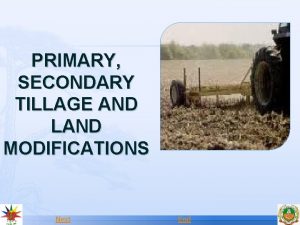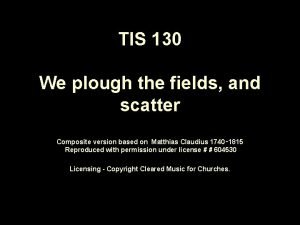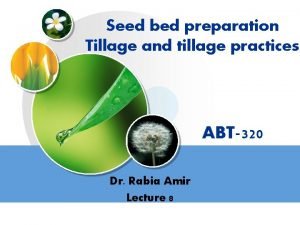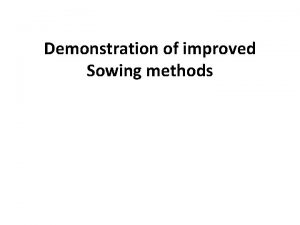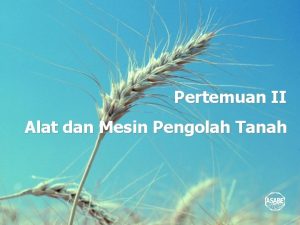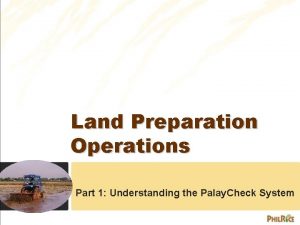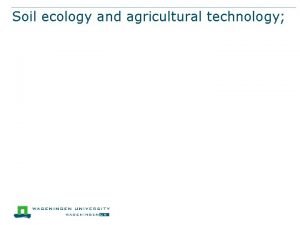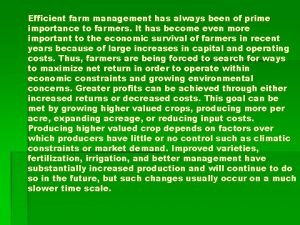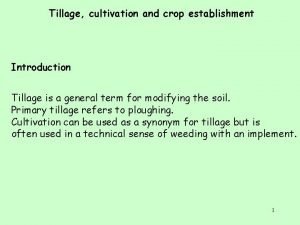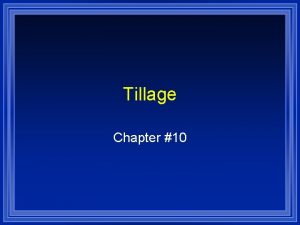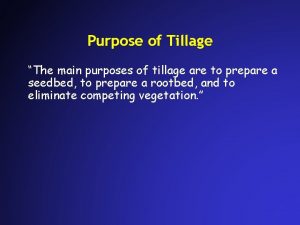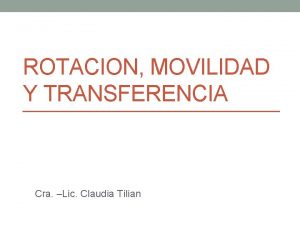Clean Tillage Tillage AngloSaxon word Tilian to plough


















- Slides: 18


Clean Tillage: Tillage; Anglo-Saxon word Tilian- to plough and prepare soil Teolian- to sow/cultivate & raise crops is defined as the mechanical manipulation of the soil aimed at improving its physical condition or tilth. Tillage It can also be described as the practice of modifying the state of soil in order to provide conditions favorable to crop growth.

What is Clean Tillage? l Mean excessive tillage l Tillage of each & every part of the field including bunds canals etc.

Effects of Reduced Tillage l Soil surface becomes very much loose which results in erosion l Reduced tillage results in a hard pan below the upper soil layer and effects the infiltration l Organic matter level decreases which disturb the soil nutrient level

PRIMARY AIMS OF CLEAN TILLAGE l l Production of suitable tilth Control of weeds Control of soil moisture Incorporation of organic matter and agrochemicals for weeds and pest control. Tilth is the physical condition of soil resulting form tillage Soil in a good tilth when it is mellow, friable & aerated Good tilth supposed to permit: Rapid infiltration of rain water Offer little resistance to root penetration

OBECTIVES OF CLEAN TILLAGES There are several major objective of tillage. 1. l l PREPARATION OF SEEDBED Weed free soil, which prevents the loss of precious water and plant nutrients to weeds. Granular soil structure, which allows close contact of the seed and the plant roots with soil particles. soil free of compacted soils, which reduce air and water penetration and inhibit root development. Level soil surface which facilitates planting seeds at a uniform depth and is especially important for proper water management in irrigated areas.

2. MANIPULATION OF PLANT RESIDUES AND FARM WASTES Incorporation of organic matter results in; l Increased soil fertility. l Increased water penetration and water holding capacity. l Enhanced soil microbial activities.

3. MANAGING WATER IN SOIL Successful tillage systems and practices have recently been developed specifically for proper moisture conservation in rain fed areas and a large array of tillage implements has been tested. l Farmers of Barani Areas normally do 8 -10 shallow ploughings with a cultivator for moisture conservation of rain water. l

5. PREVENTING WIND AND WATER EROSION Rain fed areas are often subject to wind and water erosion, an acceptable and appropriate tillage system must provide for soil erosion prevention and control. l One mould board ploughing with planking followed by two ploughings with a cultivator and planking will create rough soil surfaces containing clods from. 5 -5 cm which will help control both wind and water erosion. l

EFFECT OF TILLAGE ON SOIL CONDITIONS 1. EFFECT ON SOIL MOISTURE: l Tillage practices and systems have been developed to facilitate water penetration into the soil and increases the amount of water retained for crop use l Excessive shallow tillage operations results in increase soil compaction which restricts root growth, impedes air exchange and also creates problems in soil drainage

2. SOIL WATER RETENTION The rough soil surface and depressions caused by tillage decreases run off l This results in storing part of rain water in the soil profile l

4. CONTROLLING WEEDS l With the use of mechanical tillage practices, weeds can be controlled effectively and economically.

3. INFILTRATION l Tillage enhances infiltration of water if large voids are produced in a soil layer 4. EFFECT ON SOIL STRUCTURE l Tillage directly effects the roughness and bulk density of the soil. l These factors in terms directly affect water infiltration, crusting and compaction which in turn affect seedling emergence, root development and nutrients up take

5. EFFECT ON SOIL TEMPERATURE l Research had shown that different tillage practices results in differences in soil temperature e. g. straw or stubble mulch l However it may be disadvantage in the spring when seeding would be delayed

6. EFFECT ON EVAPORATION l Surface roughness caused by loosening of the upper soil layer by tillage increases the area of the soil exposed to the atmosphere and increase evaporation

7. EFFECT ON SOIL MICROORGANISMS Appropriate soil tillage practices will improve the soil structure, moisture, air and temperature which will ultimately increase the number and activity of microorganisms l If tillage affects temperature and moisture and manipulate crop residues, it will certainly effects micro-organism l

8. EFFECT ON NUTRIENTS UPTAKE l Nitrogen is probably the nutrient most affected by tillage although both P and K are also influenced l Warm moist soil has greater microorganism activity, which results in greater mineralization of N and in turn results in its higher up take by plants

 Explain primary and secondary tillage
Explain primary and secondary tillage Anglosaxon history
Anglosaxon history Heptarchy definition
Heptarchy definition Anglo saxons alphabet
Anglo saxons alphabet Clean up everybody let's clean up
Clean up everybody let's clean up We owe allegiance to no crown apush
We owe allegiance to no crown apush We plow the fields and scatter
We plow the fields and scatter Jack clitheroe
Jack clitheroe My father worked with a horse
My father worked with a horse The plough and the stars characters
The plough and the stars characters Objectives of tillage
Objectives of tillage Venerate the plough meaning
Venerate the plough meaning Sowing behind the country plough
Sowing behind the country plough Secondary tillage
Secondary tillage Differentiate wetland and dryland preparation
Differentiate wetland and dryland preparation Ffa creed emblem
Ffa creed emblem Tillage
Tillage Zero tillage definition
Zero tillage definition Body clean
Body clean
